9 Quintessential Thai Amulets
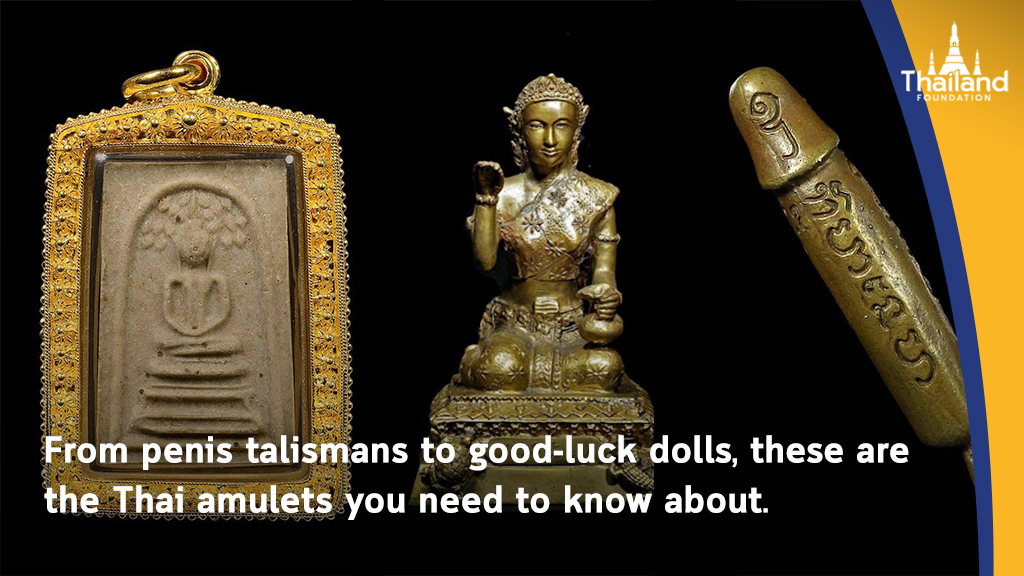
The practice of worshiping amulets and sacred objects has been taking root in the Thai society since ancient times. In addition to supernatural beliefs, each amulet is a reflection of the Thai way of life deeply intertwined with agriculture, familial tie, gratitude, history, and influences from other religions and countries. In this article you will learn about nine amulets from Thailand that are popular among Thais and foreigners alike.
- Buddha Amulet (Phra Khrueang)
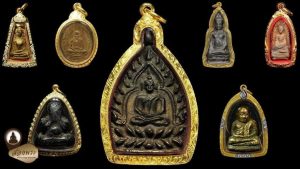
[song-pra.com]
Buddha amulets [พระเครื่อง] are small Buddha images but they can also feature images of monks, maestros, the Bodhisattvas, and other gods. Thais believe that these amulets will protect them from danger, make them invincible, and bring good luck. The amulets are small so that they can be made in large numbers as miniature replicas of the Lord Buddha. If Buddhism declines in the future, these amulets will be the evidence of the golden era of Buddhism. In the past, warriors carried the amulets with them. Nowadays, we can see them around people’s necks as lucky charms.
Amulets trading is a high value business. Rare specimens can be very expensive. Phra Soom Kor, for example, was found in a large pagoda in the province of Kamphaeng Phet and is believed to be created by a king in the Sukhothai period (AD 1238-1438). Today, it is staggeringly priced at 50,000,000 THB or around 1,482,799 USD!
- Kuman Thong (the golden child)
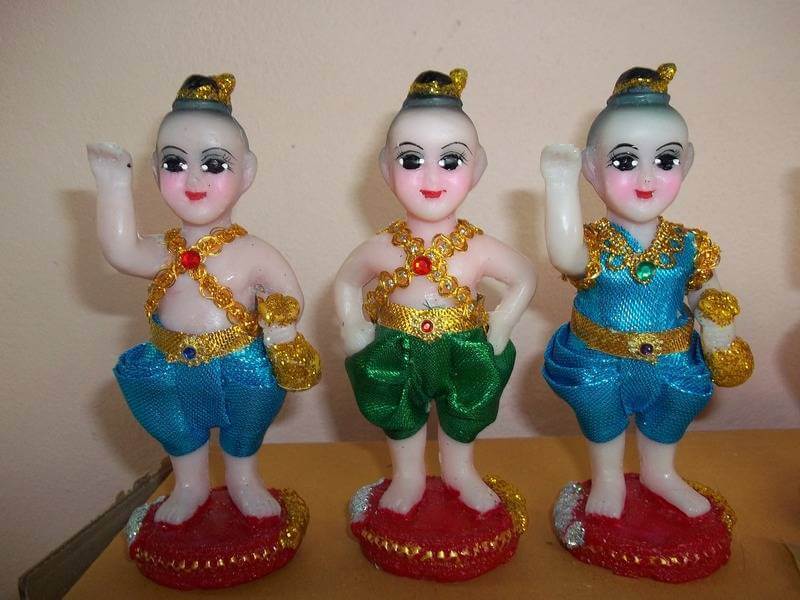
[thaitechno.net – Brand: เทพ]
Kuman Thong [กุมารทอง] is a spirit of a stillborn baby boy adopted by a shaman as a child of his own. Nowadays, we do not need such a tragedy to happen to be able to have a golden child because it can be created from either the soil from seven cemeteries, from milkweeds or gooseberry wood, or from metals. These materials are then shaped as a boy statue with a topknot hair style and dressed in Chong Kraben (a wraparound cloth worn in the Southeast Asian countries), and a child’s spirit is conjured up and invited to reside in the statue.
With a boy spirit inside, Kuman Thong should be taken care of as if it were a real child. Kuman Thong keepers must feed the statue and invite him to join the table. In return, Kuman Thong will protect its owners from disasters, bring prosperity, and keep an eye out for enemies.
- Nang Kwak (goddess of fortune)
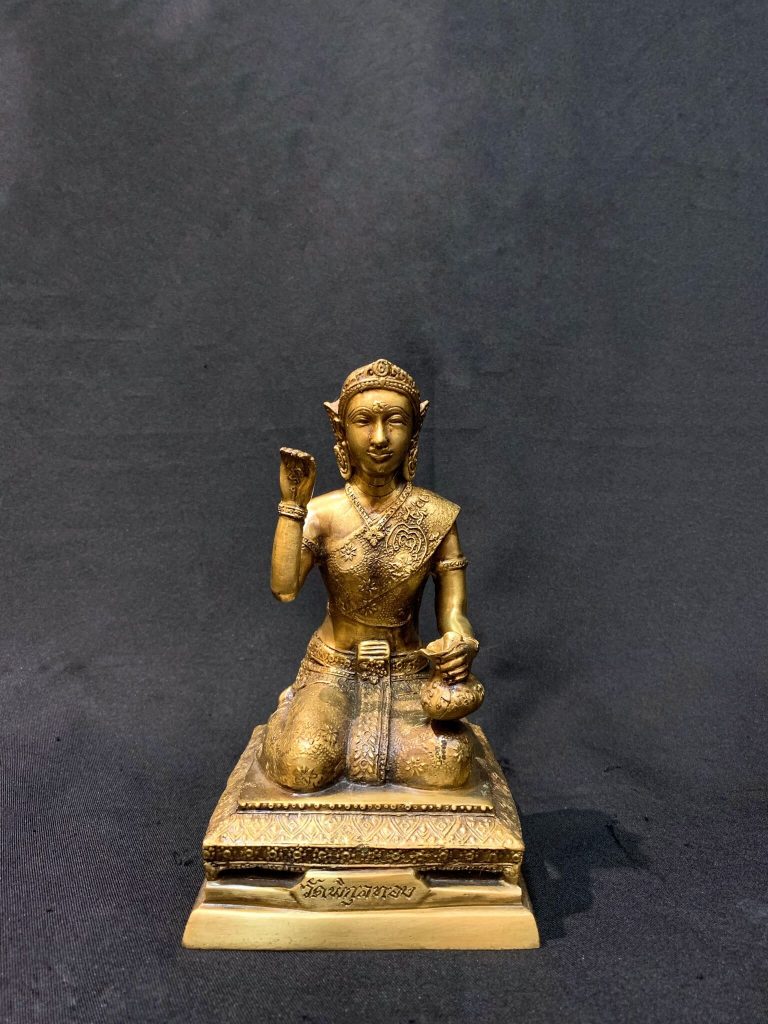 [mingmongkolstore.com]
[mingmongkolstore.com]
Nang Kwak [นางกวัก] is the goddess of fortune according to Thai traditions. The statue of Nang Kwak features a woman wearing a traditional Thai costume and accessories, sitting on the floor with legs folded to one side (nung pub piab), the left hand placed on her side or her lap, and the right hand raised to shoulder level in a beckoning gesture. Believed to beckon wealth and customers, Nang Kwak can be seen at many shop fronts and business establishments in Thailand.
The origin of Nang Kwak is still shrouded in mystery. In Buddhism, it is said that Nang Kwak, whose real name was Supavadee, was a daughter of a merchant family. Supawadee listened and observed the teachings of two Buddhist monks – Phra Kassapa Thera and Phra Sivali Thera – and was blessed by them. Thanks to Supavadee’s strong faith in Buddhism, her family’s business prospered to the extent that people made and worshipped statues of Supavadee. Another legend comes from the Ramayana epic. One giant was shot by Rama’s arrow. Prachan, the giant’s daughter, came to take care of her father but was chased away by townspeople. “Pu Chao Khao Khio” (the hermit of the green hill) upon learning of Prachan’s plight sent his beautiful daughter to keep her company. Falling for the charm of the daughter, the townspeople who once despised Prachan became friends with her and brought her tributes. Prachan then named the daughter of Pu Chao Khao Khio “Nang Kwak.”
From a sociological point of view, Nang Kwak has its roots in the ancient matriarchal culture of the Thai people, which prevailed prior to the arrival Buddhism and Hinduism. In Thai animism, women hold a special spiritual status. Many important spirits worshipped by the people are female, such as Mae Pho Sop (goddess of rice). That is to say, Nang Kwak is a local female spirit that evolved into a deity of fortune.
The statues of Nang Kwak was first found in Thailand in the Ayutthaya period (AD 1350-1767). Later in the Rattanakosin era (the modern time), the worship of Nang Kwak became more evident during the reigns of Kings Rama IV and V thanks to the economic growth in those periods. It was also around this time that the famous beckoning cat or “maneki-neko” of Japan made it first appearance in Thailand.
- Palad Khik (penis amulet)
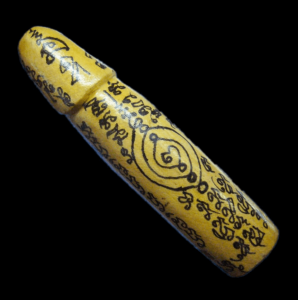 [theonlinefilmfest.com]
[theonlinefilmfest.com]
Palad Khik [ปลัดขิก] is a replica of a penis of an adult, often made of wood and used as an amulet. For many foreigners, it is a collectible.
The worship of this penis amulet has no erotic purpose whatsoever. According to a traditional belief, this practice spread to Thailand from India around 2,000 years ago. There are many legends trying to explain the origin of this worship, but the most convincing story is based on the worship of the Trimurti: Shiva, Brahma, and Vishnu. The three deities once appeared to worshipers. Brahma appeared with four faces and four arms while Vishnu appeared in his deity form, but Shiva only made his masculine part visible. After this apparition, amulets were created to represent the three deities as they appeared.
Thais adopt this Hindu belief and hang the amulet at the waist, believing that it will save them from harm. Even small children benefit from this amulet. When children are around 3-4 years old, they will start to wean off breast milk and are prone to getting sick because their immunity will decline. In the old days, when children fell ill, parents believed that a ghost was coming to take them away, but they could trick the ghost into believing that the sick children were already grown-ups simply by hanging an amulet shaped like an adult’s penis at the children’s waists.
- Yantra
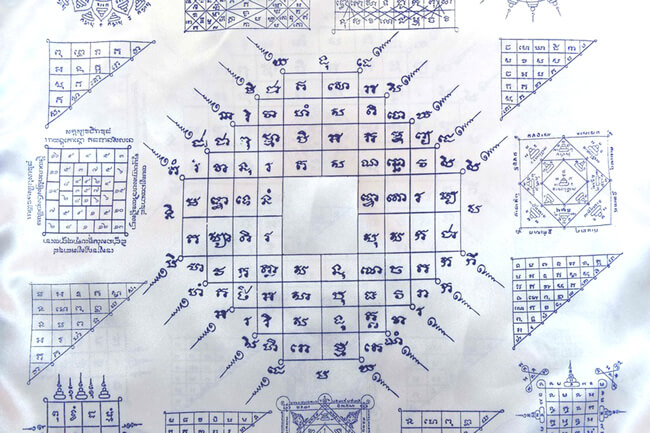
[Manager Online]
Have you ever seen the intricate and mysterious tattoos on Angelina Jolie’s back? The actress traveled all the way to Thailand to get those holy graphics inked on her. A yantra [ยันต์] can be grids, lines, numbers, characters or pictures that are written, tattooed, or engraved on a piece of fabric, skin, wood, metal, etc. If the pattern is engraved on a curled metal sheet, we call it “takrut” [ตะกรุด], and if it is inked into the skin, we call it “yantra tattooing” or “sak yant” [สักยันต์]. The sacred yantras according to Thai beliefs influenced by Hinduism can be classified into 4 groups: 1) Square yantra referring to the four elements and the four continents, 2) Triangular yantra representing the Triple Gem in Buddhism, or the Three Gods or the Trimurti, 3) Circle yantra referring to Brahma, and 4) Image yantra, which can take various designs and meanings.
The text in the yantra is composed with ancient Khmer characters, which were widely used by the ancient peoples of the region, and is an abbreviated version of sacred incantations. In the past, people tattooed yantras to boost their morale and confidence, prove their faith, and create miracles. Yantras tattooed on different parts of the body would then be sanctified by enchanters, but the tattooees themselves must also have faith and respect in the incantations and morality. In the end, the yantra will only strengthen the morale of those who truly believe in it.
- Khwai Tanu (guardian buffalo)
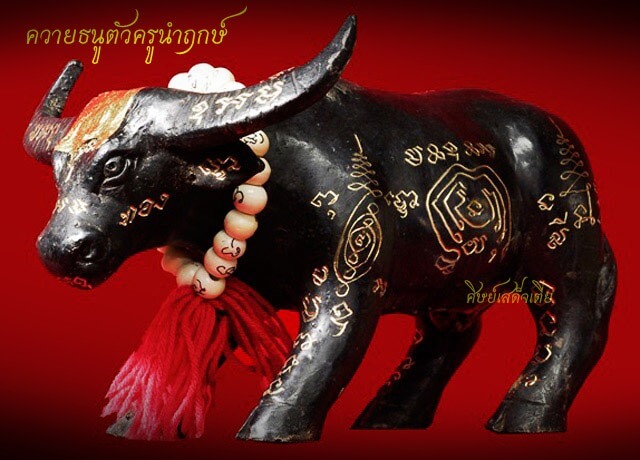
[ศิษย์เสด็จเตี่ย: www1.g- pra.com]
Through “Khwai Tanu” [ควายธนู] or the guardian buffalo, we can observe the superstitious beliefs that stemmed from the agricultural society of Thailand and the practice of rice farming and buffalo raising. This guardian buffalo is a puppet that can be made from a variety of materials, such as bamboo, clay, beeswax, or cursed metals like coffin nails from seven cemeteries, steel from pagoda tops, etc. The buffalo puppet has to be consecrated according to the ritual. Owners of the Khwai Tanu amulets must feed them well with grass and water and let them roam free from time to time. The belief in the guardian buffalo exists in every region of Thailand. Some believe that it can be used to guard houses or rice fields, protect the owners against ghosts and thieves, and can even be ordered to kill enemies. In some places, however, it is seen as just another amulet to carry around.
- Jatukham Rammathep
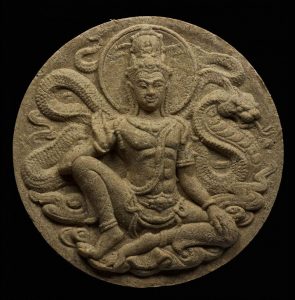
[praasia.com]
At the beginning of 2007, Jatukham Ramthep [จตุคามรามเทพ] was the most popular amulet in Thailand. The price of the very first Jatukham Ramthep amulet created in 1987 skyrocketed to over 40 million THB from the original price of only 49 THB.
Jatukham Ramthep are two gods – Thao Khattukham and Thao Ramthep – who guard Wat Phra Mahathat Woramahawihan Temple in Nakhon Si Thammarat. According to the belief in Brahmanism, both are supreme deities: Jathukham being a name for the creator god Brahma and Rammathep being a name for Lord Rama, an avatar of the god Vishnu. Later, they were renamed to Thao Jatukham. Another belief, which is a local legend in the southern Thailand, says that Jatukham Ramathep was a king of the Nakhon Si Thammarat Kingdom (AD 1287). Once he successfully established the Srivijaya Kingdom, this monarch and mighty warrior was lauded as “the Black King of the Southern Seas” after his dark skin tone.
- Sai Dak Sap (bamboo fish trap of fortune)
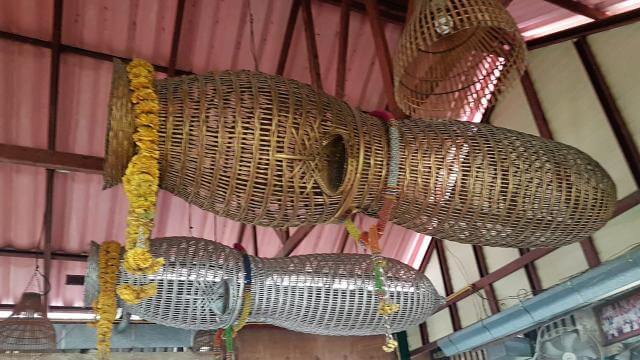
[Thairath]
Another amulet that depicts a bond between the Thai people and nature is the Sai Dak Sap [ไซดักทรัพย์]. A sai is a traditional Thai fish trap, which has later become a lucky charm called “Sai Dak Sap” believed to help trap money, property and bring good fortune to the worshipers. Many shops and stores like to hang the sais at the facades of their establishments for prosperity and to improve their Feng Shui. The greater the faith, the larger the sai. It is also believed that the sai will bring happiness to the families and the businesses of the owners. To obtain the best lucky effect, a sai must be hung high with its mouth turned toward the outside of the shop or the house to bring in good fortune and money. Never point the mouth of a sai to the side or inside the house as this may draw the fortune away from the owners.
- Mom’s skirt
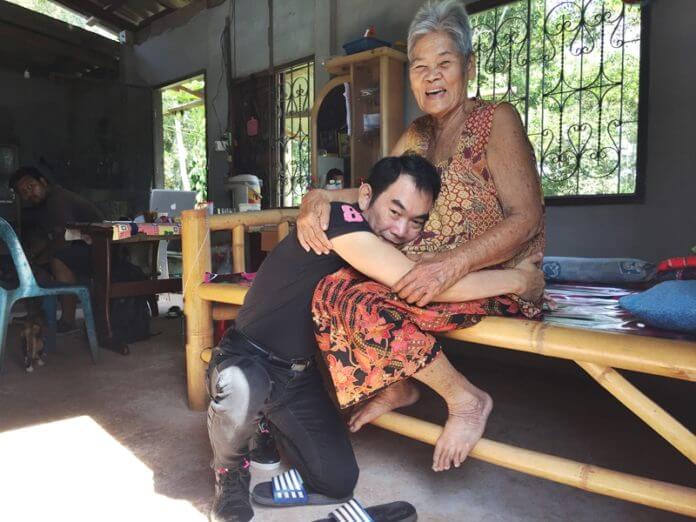
[Khaosod]
In the old times when men were often called to serve at wars, every young man would take one special sacred object with them to boost morale and keep them safe. It was a strip of cloth torn from their mother’s skirts which are similar to sarongs. Sons would tie this cloth around their arms or carry it with them. Although today wars are less frequent than before, the power of the mother’s skirts still plays a role in protecting her son against black magic and keeping his family together. Some Thais believe that a married man who leaves his wife for a mistress must be a victim of black magic. In order to break the curse, the man must put on his mother’s sarong from the head and take it off at his feet. Today, sarongs may not be in fashion anymore, but we can use the rim of mom’s trousers as a substitute. Mix a few drops of water from the rim of mom’s trousers in drinking water and let the son drink it. This will lift the curse, and the son will return to his wife and family.
A simple strip of cloth is a symbol of respect and love, and the connection between a mother and her child. This lucky charm derives its power from the love of the mother. No matter where her sons are or what they are facing, the love of mothers will ward off evil and protect their children from all dangers.
———————————
And those are the best-known nine amulets in Thailand. In the modern world where we are inclined to seek explanations from science, it is understandable if some will turn against or criticize these superstitions. There is one thing, however, that will always stand the test of time. These amulets are the proof of the openness of the Thai people toward cultural diversity, our life guidance that places familial piety and gratitude at the core, and our respect for nature.
Sources
- Buddha Amulet
- ณัฐพล อยู่รุ่งเรืองศักดิ์ [Nattapol Yoorungruengsak]. ประวัติศาสตร์ผ่านพระเครื่อง [History Through Buddha Amulets]. Nakhon Pathom: Silpakorn University Printinghouse, 2012.
- Kuman Thong
- Nang Kwak
- Palad Khik
- Yantra
- Khwai Thanu
- Jathukham Rammathep
- Sai Dak Sap
- Mom’s Skirt
Author: Soonyata Mianlamai
Cover Graphic: Fahon Mongkolrat


